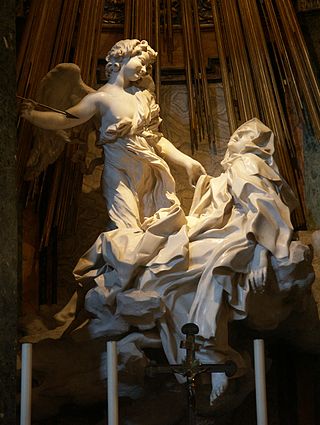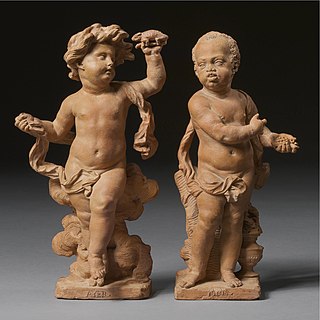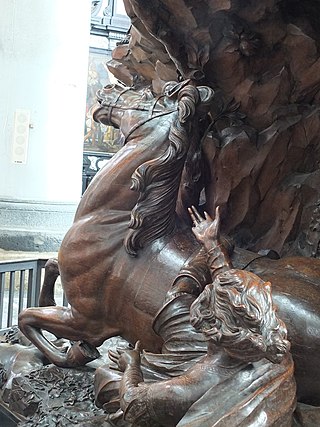
Baroque sculpture is the sculpture associated with the Baroque style of the period between the early 17th and mid 18th centuries. In Baroque sculpture, groups of figures assumed new importance, and there was a dynamic movement and energy of human forms—they spiralled around an empty central vortex, or reached outwards into the surrounding space. Baroque sculpture often had multiple ideal viewing angles, and reflected a general continuation of the Renaissance move away from the relief to sculpture created in the round, and designed to be placed in the middle of a large space—elaborate fountains such as Gian Lorenzo Bernini‘s Fontana dei Quattro Fiumi, or those in the Gardens of Versailles were a Baroque speciality. The Baroque style was perfectly suited to sculpture, with Bernini the dominating figure of the age in works such as The Ecstasy of St Theresa (1647–1652). Much Baroque sculpture added extra-sculptural elements, for example, concealed lighting, or water fountains, or fused sculpture and architecture to create a transformative experience for the viewer. Artists saw themselves as in the classical tradition, but admired Hellenistic and later Roman sculpture, rather than that of the more "Classical" periods as they are seen today.

Jan Claudius de Cock was a Flemish painter, sculptor, print artist and writer. De Cock produced both religious and secular sculpture on a small as well as monumental scale. De Cock completed many commissions in the Dutch Republic. He worked on decorations for the courtyard of the Breda Palace for William III, King of England, Ireland, and Scotland and stadtholder. He is credited with introducing neoclassicism in Flemish sculpture. He was a prolific draughtsman and designed prints for the Antwerp publishers. As a writer, he wrote a poem about the 1718 fire in the Jesuit Church in Antwerp and a book of instructions on the art of sculpture.

St. Andrew’s Church is a Catholic church in Antwerp built in the 16th century. Its exterior is mainly characterised by a late-Gothic style while its interior is predominantly executed in Baroque style. It is the parish church of the Parish of St. Andrew’s. During the nineteenth century the St. Andrew's Parish was known as the parish of misery as it was by then mainly populated by poor people.

Goswin van der Weyden or Goossen van der Weyden (1455–1543) was a Flemish Renaissance painter active in Antwerp. He was one of several artists from Brussels who assisted in the transmission to Antwerp of the traditions of the Brussels school founded by his grandfather, Rogier van der Weyden. He thus played an important role in the founding of the Antwerp school.

Johannes van Mildert or Hans van Mildert was a Flemish sculptor, who is best known for his baroque sculptures found in many Belgian and Dutch churches. Van Mildert played an important role in the development of the design of Flemish Baroque religious furniture.

St. Paul's Church is a Roman Catholic church located at the Veemarkt in Antwerp, Belgium. Its exterior is mainly Gothic with a Baroque tower while the interior is characterised by its rich Baroque decoration. It holds paintings by Antwerp's leading artists Peter Paul Rubens, Anthony van Dyck and Jacob Jordaens as well as abundant sculpture and church furniture crafted by leading Antwerp sculptors such as Artus Quellinus the Elder, Pieter Verbrugghen I, Jan Pieter van Baurscheit de Elder, Jan Claudius de Cock and Andries Colyns de Nole. Of particular note is the Calvary outside the Church which is made up of 63 life-size statues and nine reliefs executed in a popular and theatrical style.

Artus Quellinus II or Artus Quellinus the Younger was a Flemish sculptor who played an important role in the evolution of Northern-European sculpture from High Baroque to Late Baroque.

Pieter Scheemaeckers, Pieter Scheemackers, Pieter Scheemaeckers I or Pieter Scheemaeckers the Elder was a Flemish sculptor who played an important role in the development of Baroque church sculpture in the late 17th-century Habsburg Netherlands. He was also known for his marble funerary monuments an small scale ivory works. He was the father of Peter Scheemakers who became a leading sculptor of portraits and church monuments in 18th century London.

Frans Langhemans was a Flemish sculptor mainly active in Mechelen. He worked for a time as a court sculptor in Düsseldorf. He is mainly known for this church furniture and statues of saints.

The St Walburga Church in Antwerp, Belgium, formerly a parish church, was demolished in 1817.

Willem van den Broecke, Willem van den Broeck or Guillelmus Paludanus was a Flemish sculptor, painter, draughtsman and architect. He was a scion of a family of artists, which had its origins in Mechelen and some members of which later moved to Antwerp. Willem was active in Antwerp and also worked and likely trained in Italy for a long period. He was known for his small scale works, many of which were executed in alabaster. He was, along with Cornelis Floris, the leading sculptor in Antwerp in the second half of the 16th century. He was also one of the designers of the Antwerp City Hall. He enjoyed the patronage of an elite international clientele of church institutions, Spanish nobility, princes of Protestant territories as well as patricians from Augsburg.

Laurys Gillis or Laurent Gillis was a Flemish sculptor who was active in Antwerp in the first half of the 18th century. He worked for a long time in the workshop of the prominent Antwerp sculptor Michiel van der Voort the Elder. He is known for statues of historical and biblical figures, Christian saints and allegorical respresentations.

Michiel van der Voort the Elder, Michiel van der Voort (I) or Michiel Vervoort the Elder, nickname Welgemaeckt (Antwerp, 3 January 1667 – Antwerp, buried on 8 December 1737) was a Flemish sculptor and draftsman, who is best known for the Baroque church furniture which he made for the principal churches in Flanders. He also produced secular works, particularly of mythological and allegorical subjects. His work expresses both late Baroque exuberance and the quest for the simplicity of Classicism. His oeuvre shows the influence of Michelangelo, François Duquesnoy and Rubens. He trained many members of the next generation of Flemish sculptors.

Norbertus van den Eynde (I), Norbrecht van den Eynde and Norbert van den Eynde (also spelled: Norbertus van den Eynden, Norbert van den Eynden, and Norbertus van den Eynden) (Antwerp, baptized 11 December 1628 – Antwerp, 7 October 1704) was a Flemish sculptor. He is mainly known for his religious sculptures and church furniture. He was the son of the prominent sculptor Huibrecht van den Eynde and a member of the van den Eynde family of sculptors. Van den Eynde was a close associate of Artus Quellinus II. He undertook several commission in the Antwerp Cathedral, including several altarpieces.

Huibrecht, Hubrecht, Hubertus or Hubert van den Eynde was a Flemish sculptor. He is mainly known for his religious sculptures and church furniture although he also worked on some secular projects. He was the first prominent sculptor of the van den Eynde family of artists and merchants. In the early 17th century, van den Eynde was one of the leading Flemish sculptors who rejected contrived Mannerist formulae in favour of greater realism. His work shows a development from the early Baroque to the high Baroque. His late style is characterized by a penchant for movement and dashing draperies.

Lodewijk Willemsens or Ludovicus Willemsens (1630–1702) was a Flemish sculptor from Antwerp. His works comprise mostly sculptured church furniture, and to a lesser extent individual sculptures, both portrait busts as well as statues of saints for churches.

Willem Kerricx or Willem Kerricx the Elder was a Flemish sculptor active in Antwerp. His works comprise mostly sculptured church furniture, individual sculptures, both portrait busts as well as statues of saints for churches and funerary monuments. His style shows the transition from the highly dramatic expressiveness of the Antwerp late Baroque towards a more gracious and elegant Rococo style. He operated a large workshop in Antwerp which was continued by his son into the middle of the 18th century.

Alexander van Papenhoven was a Flemish sculptor, architect and art educator, who is best known for the furniture which he made for the principal churches in Flanders. He worked mainly in Antwerp, but early in his career he was also active for some years in Denmark.

Albert Xavery, Albert Saverij or Albertus Xavery was a Flemish sculptor principally active in Antwerp. He produced mainly statues of mythological figures, some of them on a large scale, made to be displayed in luxurious residences or in gardens. Like other Antwerp sculptors, he exported many of his works to the Dutch Republic, where his patrons included members of the House of Nassau.

Jan Frans van Geel was a Flemish sculptor, draugthsman and art educator. He is mainly known for his church furniture, statues of saints, mythological ensembles and allegorical figures. He was a teacher and director at the Academy of Arts of Mechelen and teacher of sculpture at the Academy of Arts of Antwerp. He was one of the last Flemish sculptors who worked in the Flemish Baroque style in sculpture, which was popular in the Habsburg Netherlands in the 17th and 18th centuries.


























